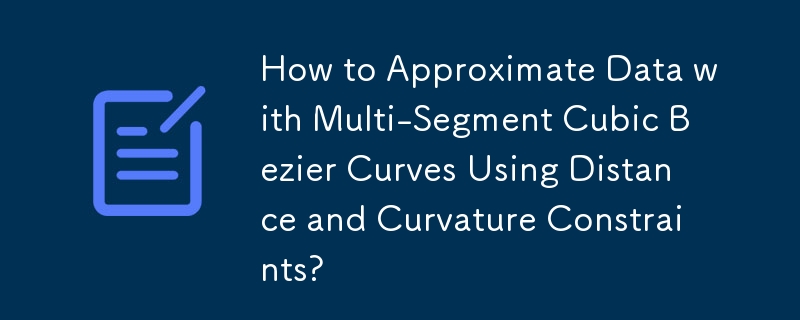Home >Backend Development >Python Tutorial >How to Approximate Data with Multi-Segment Cubic Bezier Curves Using Distance and Curvature Constraints?
How to Approximate Data with Multi-Segment Cubic Bezier Curves Using Distance and Curvature Constraints?
- Mary-Kate OlsenOriginal
- 2024-10-21 08:27:021168browse

Approximating Data with Multi-Segment Cubic Bezier Curves with Distance and Curvature Constraints
Introduction
The approximation of complex data using multi-segment cubic Bezier curves presents challenges in terms of balancing accuracy and computational efficiency. Existing algorithms often prioritize speed at the expense of curve smoothness, leading to undesirable sharp turns.
Problem Statement
To address this issue, we seek an algorithm that can approximate data with Bezier curves while adhering to two constraints:
- Distance Constraint: The Bezier curve must never exceed a specified distance from the data points.
- Curvature Constraint: The Bezier curve must not exhibit excessive curvature, ensuring a smooth and consistent shape.
Solution
The solution involves a two-step process:
- B-Spline Approximation: We first approximate the data using a B-Spline curve, which provides a natural smoothness and allows for the specification of desired "smoothness."
- Conversion to Bezier Curves: The B-Spline is then converted into a series of Bezier curves using the b_spline_to_bezier_series function.
Implementation
The implementation of this solution in Python using scipy and matplotlib is as follows:
<code class="python">import matplotlib.pyplot as plt import numpy as np from scipy import interpolate tck, u = interpolate.splprep([x, y], s=3) unew = np.arange(0, 1.01, 0.01) out = interpolate.splev(unew, tck) plt.figure() plt.plot(x, y, out[0], out[1]) plt.show() # Convert to Bezier curves bezier_curves = b_spline_to_bezier_series(tck)</code>
By adjusting the s parameter in splprep, we can control the smoothness of the approximation. The resulting Bezier curve satisfies both the distance and curvature constraints.
Conclusion
This solution provides a method for approximating data with complex shapes using multi-segment Bezier curves while enforcing smoothness and adherence to distance constraints. It is a robust and efficient approach that can handle large datasets and complex geometries.
The above is the detailed content of How to Approximate Data with Multi-Segment Cubic Bezier Curves Using Distance and Curvature Constraints?. For more information, please follow other related articles on the PHP Chinese website!

